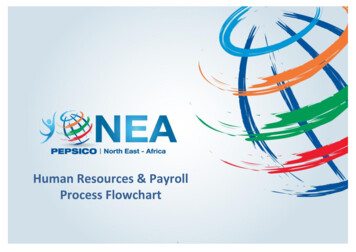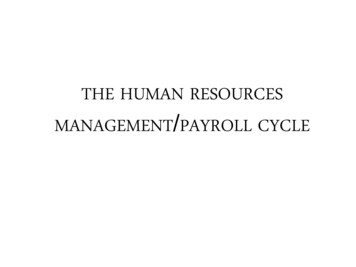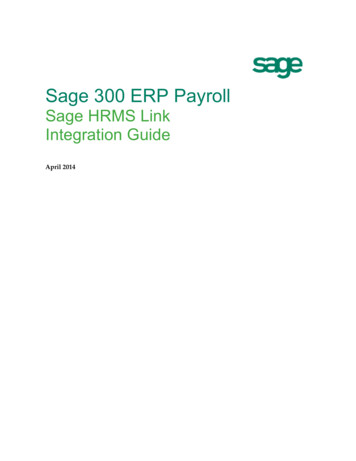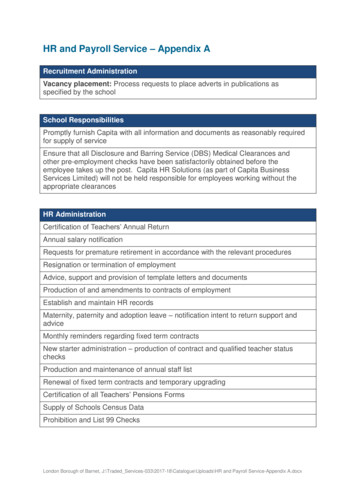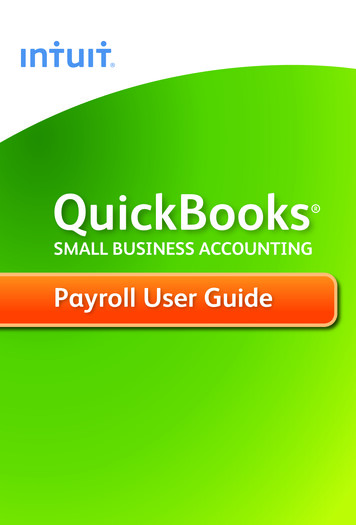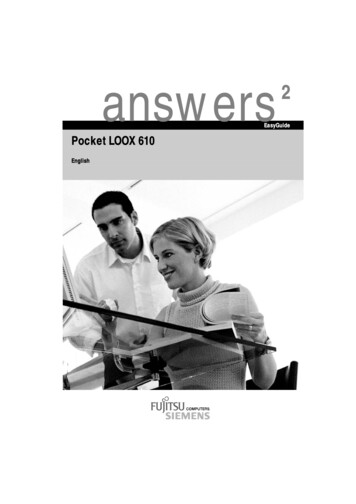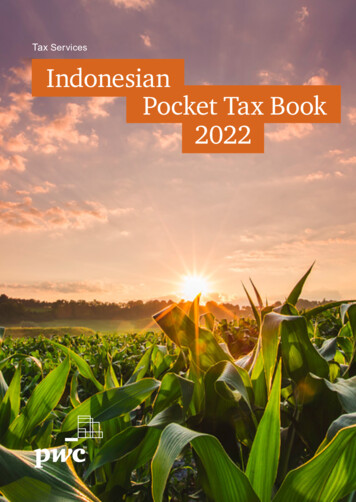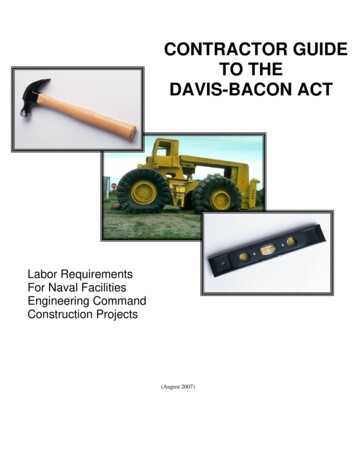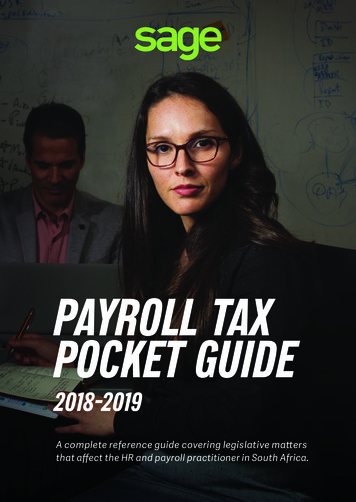
Transcription
PAYROLL TAXPOCKET GUIDE2018–2019A complete reference guide covering legislative mattersthat affect the HR and payroll practitioner in South Africa.
Quick ReferenceSubsistence AllowanceTravel inside RSA – incidentals onlyTravel inside RSA – meals and incidentalsTravel outside RSA – meals and incidentalsR128R416Schedule of limits per countryReimbursed Kilometres (Travel)Current rate is R3.61 per kilometre.Long Service AwardThe first R5 000 of the asset given to an employee is free from tax. The value ofthe asset that exceeds R5 000 is taxed as an Acquisition of an Asset.Long service is defined as an initial unbroken period of service of at least 15 yearsand any subsequent unbroken period of service of at least 10 years.Official Interest Rate (Low and Interest Free Loans/Debts)Reserve Bank repurchase rate plus 1% from 1 March 2011. The repurchase ratewas 6.75% from August 2017 and decreased to 6.50% from April 2018.UIF Limit - R14 872 per month as from 1 October 2012.OID Limit - R430 944 per annum for 2018/2019.BCEA Earnings Threshold - R205 433.30 per annum as from 1 July 2014.Medical Scheme Fees Tax Credits R310 for main member R310 for first dependant R209 for eachadditional dependant.BursariesA bona fide bursary, enabling a person to study at a recognised educational orresearch institution.Open bursary: Exempt from tax.Closed bursary: Exempt if granted to an employee and the employee agrees torepay the employer if the employee does not complete the studies. Also exempt ifgranted to a relative of an employee, unless the employee’s remuneration for theprevious year of assessment was above R600 000. If the remuneration for theprevious year of assessment was R600 000 or less, the first R20 000 of the bursaryis exempt for a qualification up to NQF level 4, and the first R60 000 of the bursaryis exempt for an NQF level 5-10 qualification. As from March 2018, there aredifferent tax exemption thresholds for bursaries granted to an employee’s familymember with a disability.The following limits may change during the year: Official interestrate, UIF limit, OID limit and BCEA earnings threshold.
ContentsKey to Icons1. Terminology2. Definitions & Employees’ Tax Concepts2.1Employer2.2Employee2.2.1 Labour Broker2.2.2 Personal Service Providers (PSP)2.2.3 Independent Contractors and ‘Deemed Employees’2.2.4 Non-Executive Directors2.3Remuneration2.3.1 Remuneration Proxy2.3.2 Balance of Remuneration2.3.3 Net Remuneration2.3.4 Deemed Remuneration and Directors of Private Companies2.3.5 Variable Remuneration2.4Residence Based Taxation2.4.1 Ordinarily Resident2.4.2 “Deemed” Resident - Physical Presence Test2.5Standard Employment and Temporary Employees2.6Directives3. Allowances, Advances, Reimbursements & Other 3.4Travel Allowance3.4.1 Reimbursive Travel Allowance3.4.2 Estimating a Travel Allowance for an Employee3.4.3 Establishing the Rate per Kilometre of the Vehicle3.4.4 Travel Allowance on Assessment3.5Subsistence Allowance3.6Share Incentive Schemes3.6.1 Taxation of Gains made in respect of Rights to 61717181921Marketable Securities21Taxation of Broad-Based Employee Share Plans21
3.6.3Taxation of Vesting of Equity Instruments3.73.8Arbitration Awards22 Severance Benefit Lump Sums - Gratuities due to Retrenchment,Retirement or Death223.9Back Pay / Antedated Salaries4. Exempt Income2122234.1Uniform Allowance234.2Relocation Allowance234.3Foreign Employment Income244.4Bursaries and Scholarships244.5Lump Sum Compensation for Occupational Death255. Tax Deductions265.1Employee Contribution Towards Retirement Funds265.1.2Statutory limits265.2Income Replacement Policies265.3Employee Medical Aid Contributions275.3.1Medical Scheme Fees Tax Credits275.3.2Additional Medical Expenses Tax Credits275.4Payroll Giving (Employee Donations)286. Fringe Benefits306.1Acquisition of an Asset at Less than the Actual Value306.2Right of Use of an Asset316.3Right of Use of Motor Vehicle316.4Meals, Refreshments and Meal and Refreshment Vouchers336.5Residential Accommodation336.6Free or Cheap Holiday Accommodation356.7Free or Cheap Services provided by the Employer356.8Low or Interest-Free Loans / Debts366.9Medical Aid Contributions366.10Benefits in Respect of Insurance Policies376.11Employer Contributions Towards Retirement Funds396.11.1Defined Contribution Fund396.11.2 Defined Benefit Fund396.11.3 Hybrid Fund40
6.11.4 Retirement Funding Income (RFI)406.1240Payment of Debt or Release from Debt7. Monthly Reconciliation and Payments418. Annual Reconciliation and Tax Certificates429. Income and Assessment439.1Gross Income9.2Exempt Income43439.3Deductions from Income4410. Employment Tax Incentives (ETI)4610.1Employer4610.2Employee4610.3Incentive Amount4710.4Unavailability of the Incentive Amount4810.5Incentives Carried Forward4810.6Reimbursement of Carried Forward Incentive Amounts11. Unemployment Insurance Fund (UIF)484911.1Employee4911.2UIF Remuneration from which the Contribution must beCalculated5011.3UIF Contributions5012. Skills Development Levies (SDL)5112.1Employer5112.2Employee5112.3SDL Remuneration (Leviable Amount)5112.4Skills Development Levy5213. Occupational Injuries And Diseases (OID)5413.1Employee5413.2Earnings to be Included for the OID Annual Return (W.As 8)5413.3OID Limit55IRP5 Codes562018-2019 Tax Tables61
Key to IconsHelpful HintsGeneral information to assist with the practical application ofa topic.Budget ProposalsChanges to these items were proposed in the budget, but werenot yet promulgated at print time. Please visit our website or theSARS website, www.sars.gov.za for updated information.Possibility to ChangeThese items may change during the course of the year. Pleasevisit our website or the SARS website, www.sars.gov.za forupdated information.DISCLAIMERThis document includes amendments to the Income Tax Act (1962) up to and including the Taxation LawsAmendment Act 2017, and the Tax Administration Laws Amendment Act 2017. It also includes theproposed budget changes although these had not yet been promulgated at the time of printing.Although care has been taken with the preparation of this document, Sage makes no warranties orrepresentations as to the suitability or quality of the documentation or its fitness for any purpose and theclient uses this information entirely at own risk.The purpose of this document is to address employees’ tax and only include references to income taxwhere applicable.COPYRIGHT NOTICE Copyright 2018 by Sage under the Copyright Law of the Republic of South Africa.No part of this publication may be reproduced in any form or by any means without the expresspermission in writing.1Payroll Tax Pocket Guide 2018–2019
1. TerminologyAll references to ‘he‘ or ‘his’ includes ‘she’ or ‘her’ in the case of a femaletaxpayer, and ‘it’ or ‘its’ refers to a taxpayer other than an individual, and isnot intended to be discriminatory.The word ‘company’ when used in the context of the Income Tax Act, 1962includes a close corporation, and the term ‘director of a private company’includes a member of a close corporation who performs the same duties.A person includes both a natural person and a legal entity.A natural person for tax law purposes is: an individual, a sole proprietor, or a partner in a partnership.A legal entity for tax law purpose is: a public company, a private company, a close corporation, a trust, or any divisional council, municipal council, village management board orlike authority.Payroll Tax Pocket Guide 2018–20192
2. Definitions & Employees’ Tax ConceptsEmployees’ tax is an advance payment against the liability for income tax atthe end of the tax year, and is collected through a system of employees’ taxand provisional tax payments. The employer must withhold employees’ taxfrom all remuneration paid or payable to an employee during the tax year,and the Fourth and Seventh Schedules to the Income Tax Act have beendevoted to this requirement.Remuneration and employees’ tax are thus merely estimates to allow theadvance collection of income tax on a regular and equitable basis.The Fourth Schedule to the Income Tax Act requires three elements to bepresent before employees’ tax can be withheld for payment to SARS: an employer paying remuneration to an employee.2.1 Employer (Paragraph 1, Fourth Schedule)An employer is defined by the Fourth Schedule as being any person whopays or is liable to pay any person (natural or legal) any amount by way ofremuneration.2.2 Employee (Paragraph 1, Fourth Schedule)An employee is defined by the Fourth Schedule as: any person, excluding a company, who receives/accrues anyremuneration, any person who receives remuneration for services rendered to or onbehalf of a labour broker, any labour broker, any class or category of person declared by notice in the Gazette to bean employee, any personal service provider, and any director of a private company.2.2.1 Labour BrokerA labour broker is any natural person who for reward: provides a client with other persons to render a service or perform workfor the client, or procures other persons for a client, and remunerates those otherpersons for their services to or work done for the client.3Payroll Tax Pocket Guide 2018–2019
SEAMLESS ACCOUNTINGAND PAYROLLINTEGRATIONBusiness management solutions that seamlessly integrate toensure simple management of your payroll and accounting offices.sage.com/zaPayroll Tax Pocket Guide 2018–20194
A labour broker must always be processed on the payroll, whetherin possession of an IRP30 or not. Note that a labour broker foremployees’ tax purposes can only be a natural person.If the labour broker is not in possession of an IRP30 exemption certificateissued by SARS, employees’ tax must be withheld from the payment madeto the labour broker.All payments made to a labour broker with an IRP30 must be reported onthe tax certificate against code 3619, and all payments made to a labourbroker without an IRP30 must be reported on the tax certificate againstcode 3617.2.2.2 Personal Service Providers (PSP)A company or trust is classified as a personal service provider if:(tick the appropriate blocks) any services are rendered personally to a client of the company1or trust by a connected person to the company or trust,And the person would be regarded as an employee had he renderedthe services directly to the client (i.e. not through the company/trust),Or the service must be performed mainly at the premises of the client2 and the service provider is subject to control or supervision as tothe manner in which the service is performed,Or more than 80% of the income of the company or trust from servicesrendered consists, or is likely to consist of amounts received fromany one client,Except if the company or trust throughout the year of assessment employs3 or more employees who are on a full time basis rendering the3 service on behalf of the company, other than a shareholder ormember of the company or trust or a connected person to suchperson.If (1) and (2) is ticked, the company or trust is a PSP.If only (1) or (2) is ticked, the company or trust is not a PSP.If (3) is ticked, the company or trust is not a PSP, even if (1) and (2) is ticked.5Payroll Tax Pocket Guide 2018–2019
If the only ground on which the entity is declared to be a PSP is the “80% ofservice income” rule, the entity may supply the client an annual affidavitthat it does not receive 80% of its service income from any one client, andthe client may rely on this affidavit in good faith.A personal service provider is taxed at a rate of: 28% for a personal service provider company and 45% for a personal service provider trust.A company or trust that is not a personal service provider mustnot be loaded into the payroll, nor receive a tax certificate.2.2.3 Independent Contractors and ‘Deemed Employees’When dealing with natural persons only, an amount paid for servicesrendered is excluded from remuneration if the payment is made to: a resident of South Africa and the payment is for services rendered in the course of carrying on anyindependent trade.A person will not be an independent contractor (i.e. is an employee foremployees’ tax purposes) if he:is not a resident of South Africa, or1renders services to or on behalf of a labour broker, oris a personal service provider, oris a labour broker, or if services must be performed mainly at the premises of the personpaying for or requesting the service and the service provider is2subject to control or supervision as to the manner in which theduties are performed or to the hours of work.Except if the person throughout the year of assessment employs 3 or more3 employees who are on a full time basis rendering the service onbehalf of the person, other than connected person to such person.If (1) is selected at any time, the person is not an independent contractor.If only (2) is selected, the person is not an independent contractor.If (2) and (3) are selected, the person is an independent contractor.The amount paid for services rendered by an individual who is determinedPayroll Tax Pocket Guide 2018–20196
not to be an independent contractor is deemed to be remuneration and issubject to PAYE.Report all remuneration paid to an independent contractor onthe tax certificate against code 3616.2.2.4 Non-Executive Directors (SARS Binding General Ruling 40)SARS issued Binding General Ruling 40 to clarify the employees’ taxconsequences of income received by a non-executive director (NED)effective 1 June 2017.The Ruling confirms that resident non-executive directors are not commonlaw employees and that no control or supervision is exercised by thecompany, over the manner in which a NED performs his/her duties or theNED’s hours of work. The fees received for services rendered as a NED donot constitute remuneration and no PAYE must be withheld.This applies to a non-executive director of a private and a public company.The resident NED may request the employer to deduct voluntary PAYE frompayments made to him/her.This is not applicable to non-resident NEDs. Fees earnedfor services rendered by a non-resident NED are seen asremuneration and PAYE must be withheld.2.3 Remuneration (Paragraph 1 and Paragraph 11A(1), Fourth Schedule)Remuneration is defined as any amount of income which is paid or payableby way of any salary, leave encashment, wage, overtime pay, bonus,gratuity, commission, fee, voluntary award, lump sum payment, annuity,emolument, pension, superannuation allowance, retiring allowance orstipend, whether in cash or otherwise, and whether or not in respect ofservices rendered.In addition to the general definition above, the following items arespecifically included in remuneration: annuities, any amount received for services rendered by virtue of any employmentor the holding of any office, restraint of trade payments, any amount received in respect of the relinquishment, termination, loss,7Payroll Tax Pocket Guide 2018–2019
repudiation, cancellation or variation of any office or employment,excluding lump sum awards from a pension, provident or retirementannuity fund, lump sum benefits from a pension, provident or retirement annuity fund, any amount received in commutation of amounts due under anycontract of service, the cash equivalent of any fringe benefits calculated in accordance withthe provisions of the Seventh Schedule, except the user of motor vehiclefringe benefit (see Fringe Benefits, section 6), an allowance or advance included in taxable income by section 8(1)(a)(i),other than a travel, subsistence or public office allowance, 80%/20% of any travel allowance, 80%/20% of the cash equivalent of the use of motor vehicle fringe benefit, 100% of the portion of reimbursive travel allowance that exceeds theprescribed rate per kilometre (rate per kilometre for the simplified method,fixed by the Minister of Finance by notice in the Gazette) as from March2018, 50% of any allowance granted to the holder of a public office to defrayexpenditure incurred for the purposes of his office, gains made by the exercise, cession or release of any right to acquiremarketable security as contemplated in section 8A, gains made from the disposal of any qualifying equity share ascontemplated in section 8B, gains made as a result of the vesting of any equity instrument or returnof capital as contemplated in section 8C, and certain dividends in respect of section 8C equity instruments.The following items are specifically excluded from the definition ofremuneration: amounts paid in respect of services rendered by a person ordinarilyresident in South Africa in the course of any trade carried onindependently, any pension payable under the Aged Persons Act, 1967 or the BlindPersons Act, 1968, any disability grant or allowance under the Disability Grants Act, 1968, any grant or contribution under the Children’s Act, 1960, any amount paid to an employee wholly in reimbursement ofexpenditure actually incurred by the employee in the course of hisemployment, andPayroll Tax Pocket Guide 2018–20198
any annuity under an order of divorce or decree of judicial separation, orunder any agreement of separation.2.3.1 Remuneration Proxy (Section 1)Remuneration proxy is the remuneration as defined in the Fourth Schedule,derived by an employee from an employer during the year of assessmentimmediately preceding that year of assessment.Where the employee was not employed by the employer for the whole ofthe preceding year, the remuneration he/she received from the employerfor the portion of the year he/she was employed by the employer, must becalculated pro rata for the full 365 days.If the employee was not employed by the employer for any portion of thepreceding year, the employee’s remuneration for the first month he/she isemployed by the employer, must be calculated pro rata for a full 365 days.2.3.2 Balance of Remuneration (Paragraph 2(4), Fourth Schedule)The amount of employees’ tax to be withheld from the employee iscalculated on the balance of remuneration, which is the remunerationremaining after deducting: current and arrear contributions to approved pension fund schemes andretirement annuity funds that are processed on the payroll, withinspecified limits (see Tax Deductions, section 5), at the option of the employer, current and arrear contributions toapproved retirement annuity funds by the employee for which proof wasprovided, within specified limits (see Tax Deductions, section 5), any donation by the employee, made by the employer for which theemployer received a S18A(2)(a) receipt, within specified limits (see TaxDeductions, section 5), contributions towards approved provident fund schemes, as fromMarch 2016 (see Tax Deductions, section 5).Employees’ tax calculated in terms of a directive is based onremuneration and not on the balance of remuneration.2.3.3 Net Remuneration (Paragraph 11B(1), Fourth Schedule)Net remuneration is calculated by excluding certain items from balance ofremuneration. These items include amongst other: remuneration paid to employees who are not in standard employment(temporary employees), remuneration paid to a director of a private company or a member of aclose corporation,9Payroll Tax Pocket Guide 2018–2019
travel allowances, public office allowances, annuities from benefit funds, and lump sums from retirement funds.This is not applicable from March 2016.2.3.4 Deemed Remuneration and Directors of Private Companies(Paragraph 11C, Fourth Schedule)Amendments to the Fourth Schedule to the Income Tax Act that came intoeffect on 1 March 2002 included directors of private companies (andmembers of close corporations according to section 1 of the Income TaxAct) in the definition of ‘employee’. It also removed the exclusion ofpayments made to directors from the definition of ‘remuneration’, therebyincluding these payments in remuneration.The concept of ‘deemed remuneration’ for directors was also introducedwith effect from 1 March 2002. Deemed remuneration is calculatedaccording to the following formula:Y T/NwhereY is the amount to be determined,T is the balance of remuneration of the previous year of assessment,excluding: termination lump sums, retirement lump sums or withdrawal benefits, amounts in terms of commutation of amounts under an employmentcontract, and gains made in terms of sections 8A, 8B or 8C on the Income Tax Act thatwere included in remuneration.N is the number of completed months the employee was employed by thatcompany in the previous year of assessment.If the balance of remuneration for the previous year of assessment is notyet determined, then T is the balance of remuneration of the year precedingthe previous year of assessment, increased by 20%.If the balance of remuneration for the preceding year of assessment hasalso not yet been determined, you need to apply for a directive from SARS.Employees’ tax is calculated on the highest value when actual and deemedremuneration is compared.Payroll Tax Pocket Guide 2018–201910
TAKE YOURACCOUNTING AND PAYROLLINTO THE CLOUDSecure online accounting and payroll,available anywhere, anytime, on any device.sage.com/za11Payroll Tax Pocket Guide 2018–2019
With effect from 1 March 2004, no deemed remuneration will be applicableif more than 75% of “T” in the formula consists of fixed monthly payments.A director can apply for a hardship directive (IRP3d) when the actualremuneration of the previous year is significantly larger than the estimatedremuneration for the current year.From March 2017, directors of private companies and membersof close corporations should be taxed on their actualremuneration only.2.3.5 Variable Remuneration (Section 7A, 7B and Paragraph 2(1B), FourthSchedule)Generally, remuneration is taxable on accrual or receipt, whichever eventoccurs first. However, in the case of ‘variable remuneration’, PAYE must bewithheld on the date which the amount is paid to the employee.Variable remuneration is defined as: overtime; bonuses; commission; an allowance or advance paid in respect of transport expenses such as atravel allowance, and leave paid out.2.4 Residence Based Taxation (Section 1)From 1 March 2001 the “Residence Based” taxation system replaced the“Source Based” taxation system that was previously used in South Africa.The residence based system states that an employee must be taxed on hisworld-wide income in the country where he is resident. Note thatcitizenship is not equivalent to residency - a non-South African citizen canbecome a resident of South Africa by virtue of the physical presence test,and is then liable for income tax in South Africa on his world-wide income.Non-residents must be taxed on income derived from a source withinSouth Africa.According to section 1 of the Income Tax Act, a person can either beordinarily resident or a ‘deemed’ resident by means of the physicalpresence test.2.4.1 Ordinarily ResidentThe courts have interpreted “ordinarily resident” to mean the country toPayroll Tax Pocket Guide 2018–201912
which the individual would normally return to from his wanderings. It wouldbe the country where the individual’s usual or principal residence islocated.2.4.2 “Deemed” Resident - Physical Presence TestAn individual who is not ordinarily resident during the year of assessmentwill be deemed to be a resident if he is physically present in South Africa: for more than 91 days in aggregate in the current year of assessmentand for more than 91 days in aggregate in each of the five preceding years ofassessment and for more than 915 days in aggregate during the five preceding years.If a person who is a “deemed” resident leaves South Africa for at least 330continuous days, the person will not be a “deemed” resident effective fromthe first day he left South Africa.2.5 Standard Employment and Temporary Employees(Paragraph 11B, Fourth Schedule)Employees are in standard employment if they work 22 hours or more perweek. Employees are also in standard employment if less than 22 hours perweek are worked and no other job is held. The employer must have a writtendeclaration from the employee that no other job will be held during theperiod that the employee is employed by the current employer.Employees that work less than 22 hours per week and have more than onejob are in non-standard employment, and are called temporary employees.Examples of temporary employees are: casual commissions paid, such as “spotters” fees, payments to casual workers for irregular or occasional servicesrendered, or fees paid to part-time lecturers.Employees in non-standard employment are taxed at a rate of 25% of thebalance of remuneration. If the following criteria apply, no tax may bededucted: at least 5 hours on a specific day are worked, and the daily rate of pay is less than the daily equivalent of the annual taxthreshold.Employees in standard employment are taxed by applying the latest tableof Statutory Rates of Tax to their annualised balance of remuneration.13Payroll Tax Pocket Guide 2018–2019
Standard employment in the paragraph above has been deletedfrom the Income Tax Act effective March 2016. However, theseguidelines are now contained in the SARS Guide for Employers and‘Other Employment Tax Deduction Tables’.There is a special ruling for certain labour-only sub contractors in thebuilding industry only, whereby the employer must withhold 6% ofremuneration for PAYE, 2% of UIF remuneration for UIF contributions and1% of the leviable amount for skills development levy. The directive numberfor this ruling is CON181356.2.6 DirectivesTax directives are issued in accordance with paragraph 9(1), 9(3), 10, 11 and11A of the Fourth Schedule, authorising employers how to deductemployees’ tax from certain remuneration. Tax directives are always issuedin relation to a specific tax year.The following tax directive application forms are available:IRP3(a) – Gratuities paid by the employer,IRP3(b) – Hardship directives – tax deducted at a fixed percentage,IRP3(c) – Hardship directives – a fixed amount of tax to be deducted,IRP3(d) – Hardship directives for deemed remuneration of directors (notapplicable from March 2017),Form A to E – Various lump sum benefits payable by funds,IRP3(s) – Share options: section 8A or 8C amounts.A tax directive specifying a fixed percentage already takes intoaccount expense claims and deductions that may be claimedon assessment, therefore, the tax directive must be appliedto remuneration and not balance of remuneration (i.e. beforededucting tax deductions from remuneration).Payroll Tax Pocket Guide 2018–201914
3. Allowances, Advances, Reimbursements &Other Remuneration3.1 AllowanceAn allowance is granted to an employee where the employer is certain thatbusiness related expenses will be incurred by the employee, but where theemployee does not have to account for expenses to the employer. Thevalue of the allowance is based on the expected business-relatedexpenditure.3.2 AdvanceAn advance is paid in lieu of business expenses an employee will incur andfor which the employee must provide proof to the employer. The value ofthe allowance is based on the expected business-related expenditure. Thedifference between the advance and the actual expense will be recoveredby either the employer or the employee.3.3 ReimbursementA reimbursement is a repayment by the employer to the employee forbusiness-related expenditure incurred by the employee on instruction bythe employer and is subject to proof of the expenditure.3.4 Travel Allowance (Section 8(1)(b) and Paragraph (cB) of the Definitionof Remuneration, Fourth Schedule)A travel allowance is granted to an employee in respect of travellingexpenses for business purposes. This is a fixed allowance that theemployee receives every pay period, regardless of actual businesskilometres travelled in that period.Private travel includes travelling by the employee between his place ofresidence and his place of employment or business, as well as any othertravelling done for his private purposes.Any travel expenses paid or reimbursed (other than a reimbursement foractual business kilometres travelled) by the employer, whether paid fordirectly or by issuing a garage or petrol/fuel card, are regarded as a travelallowance.For PAYE purposes, SARS requires the deduction of PAYE from 80% of atravel allowance, unless the employee uses the vehicle at least 80% forbusiness, then SARS requires the deduction of PAYE from 20% of a travelallowance. The full travel allowance must be disclosed on the employee’stax certificate against code 3701.15Payroll Tax Pocket Guide 2018–2019
3.4.1 Reimbursive Travel Allowance (Section 8(1)(b) and Paragraph (cC)of the Definition of Remuneration, Fourth Schedule)Reimbursements calculated using the actual business kilometres travelledare not regarded as being a travel allowance, regardless of the rate perkilometre used or the distance travelled. From March 2018, 100% of theportion of the reimbursive travel allowance that exceeds the prescribedrate of R3.61 (rate per kilometre for the simplified method, fixed by theMinister of Finance by notice in the Gazette) is included in remunerationand subject to PAYE.The portion of the reimbursive travel that does not exceed the prescribedrate of R3.61 is excluded from remuneration and not subject to PAYE.Report the full reimbursive travel allowance on the tax certificate againstcode 3703 if: the rate of reimbursement does not exceed the prescribed rate perkilometre, and the employee does not receive any other form of compensation for travel.Code 3703 will not be assessed, and the employee will not have toclaim business travel expenses on his annual return. Code 3703may not be reflected on a tax certificate together with code 3701,3702 and/or 3722 from the 2019 year of assessment.Report the full reimbursive travel allowanc
5.3 Employee Medical Aid Contributions 27 5.3.1 Medical Scheme Fees Tax Credits 27 5.3.2 Additional Medical Expenses Tax Credits 27 5.4 Payroll Giving (Employee Donations) 28 6. Fringe Benefits 30 6.1 Acquisition of an Asset at Less than the Actual Value 30 6.2 Right of Use of an Asset 31 6.3 Right of Use of Motor Vehicle 31
